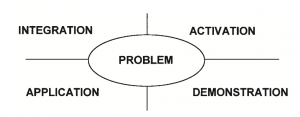Good Design, Good Projects
I spent some time this weekend re-reading Dr David’s Merrill article “Pebble-in-the-Pond Model for Instructional Design” (http://www.ispi.org/archives/resources/Vol41_07_41.pdf). I count myself lucky to have been able to take a class from Dr. Merrill and consider him one of the great minds in instructional design. In the day-to-day lives of teachers, there is rarely the opportunity to do a complete instructional design process that is advocated by instructional designers, but the ideas he lays out in this wonderful summary are the same basic structures that we use when designing good projects.
One of my favorite parts of the article is the diagram that he uses to lay out the foundations of good whole problem design:
Dr. Merrill advocates for designers to first start with the whole problem – to both engage and immerse the learners in the “why we need to know”. In much the same way, when we design good projects, we need to back up and ask what’s the essential/driving question that will direct our focus, direct our learning explorations, and give us a reason for wanting to do this work. The next step is to “identify a progression of such problems of increasing difficulty or complexity such that if learners are able to do all of the whole tasks thus identified, they would have mastered the knowledge and skill to be taught.” In other words, we need to identify the scaffolded activities that will allow the learner to build the requisite knowledge and skills to understand how to solve the whole problem. Once we know that, we can provide activities and feedback to learners so they correctly learn and apply the skills and content knowledge they need in order to work towards the whole problem.
In our work in Mid-Pacific eXploratory (MPX) and the ways that we work with other teachers through Kupu Hou Academy (kupuhouacademy.com) our work mirrors much of that found in this good instructional design methodology and there is much to be continually learned in order to apply the best design of deeper learning practices around these essential “first principles of instruction”.
One of the things that this can lead to is moving away from teaching knowledge and skills as discrete items that we might use, and instead become necessary components that one must know in order to work on the whole problem. This year in our 10th grade class, we’ve been talking about ways that we can make a difference in the prevailing issue for this generation – climate change. In the areas of transportation and energy, there are things that we can do to have an impact. We started the year with visits to sustainable buildings and Hawaiian Electric, and are breaking down this big task into components that we need to understand in order to be knowledgeable and capable enough to propose possible solutions. That means understanding motion,energy and electricity, as well as understanding the mathematics of modeling and analysis. Those are the component skills that we are developing in order to propose and create solutions to help make a difference in the big issue of our generation. By anchoring our activities in the “need to know” we create a more powerful learning experience that will stay with learners far beyond the life of this course.

